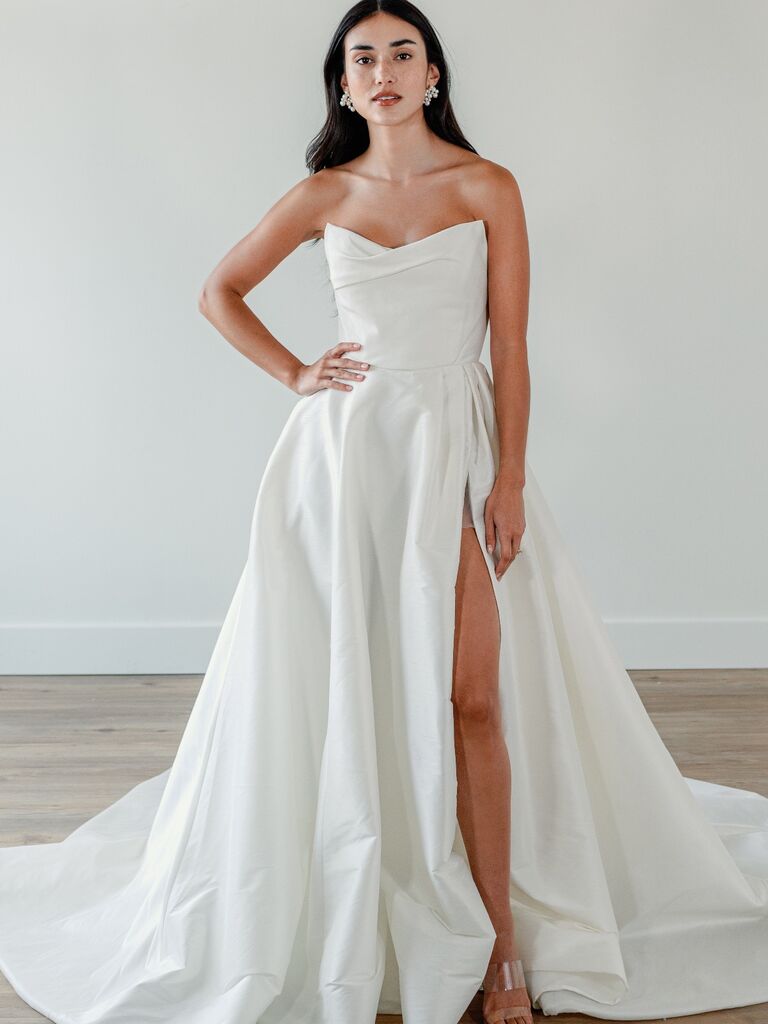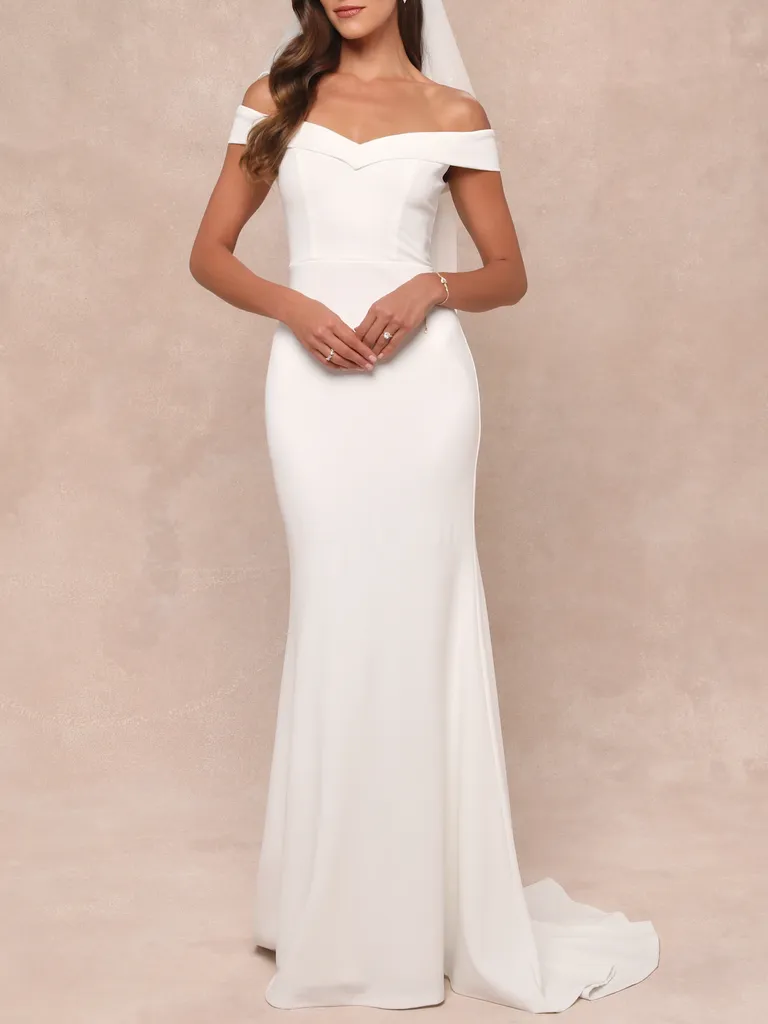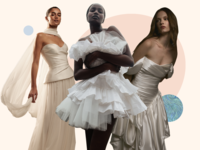Wedding Gown Fabric 101: Material Types to Know
While knowing the difference between a mermaid gown and trumpet gown can definitely help relieve some overwhelm in a sea of white dresses, there's so much more to consider about a wedding dress than its silhouette. Depending on the wedding gown fabric, two styles with the same silhouette can actually look and feel vastly different. "Fabric choice impacts the aesthetic and fit of a bridal gown," says Michael Cho, Head Designer at AMSALE. "When selecting the right dress, brides should consider how the fabric photographs, how it moves with their bodies and, most importantly, how it makes them feel on their most important day."
Whether you're prepping for your first bridal appointment or picking out fabric for a custom wedding dress, getting familiar with the most popular wedding gown fabrics is a great way to ensure you land your desired look. To help you do just that, we're bringing you an expert-backed guide to bridal textiles, complete with top tips for choosing the right one and a handy glossary that breaks down what to know about each.

In this article:
- What are the Best Bridal Gown Fabrics?
- Does Wedding Dress Material Affect Gown Cost?
- How to Choose Cloth for a Wedding Gown
- Wedding Gown Fabric Types & What to Know
What are the Best Bridal Gown Fabrics?
While there are a variety of wedding gown material options available, some are much more popular than others. Tulle, organza, silk satin, crepe, taffeta, Mikado and Duchesse satin are some of the ones you're likely to see the most when browsing dresses and fabric types. Lace is another big one—if not the biggest—as a whopping 46% of brides wore lace gowns in 2024, according to The Knot's Fashion & Attire Study. What fabric is best for you will depend on a number of factors, like your preferred wedding dress silhouette and style, how much you want to spend and the season and formality of the wedding.
Different fabrics lend themselves beautifully to different dresses, but some are more versatile than others. Sharon Sever, Head Designer at Galia Lahav, favors lace for this reason. "Lace is endlessly versatile, offering both traditional elegance and contemporary edge depending on its design and application," she says. Nadia Manjarrez, Creative Director and Founder of Nadia Manjarrez Bridal, loves to work with a mix of soft and structured fabrics. "Hand draping with lighter textiles lets us create beautiful textures, while voluminous fabrics like faille, radzimir, and taffeta add striking impact to a gown," she says. "This eclectic mix allows us to design pieces that feel both artistic and unforgettable."
Does Wedding Dress Material Affect Gown Cost?
To put it simply, higher-priced fabric typically means a higher-priced dress. And it's no secret that wedding dresses already aren't cheap. According to The Knot Attire & Fashion Study, the average cost of ceremony attire for brides was $2,000 in 2024.
But according to Sever, it's important to remember that fabric pricing isn't always black and white. This is why you may see two seemingly identical satin wedding dresses that vary greatly in cost. "The cost of wedding dress fabrics depends entirely on the quality and craftsmanship involved," she says. "For example, 'satin' can range from a basic synthetic blend to a luxurious, high-grade silk satin, each with a vastly different price point."
How to Choose Cloth for a Wedding Gown
Whether you're picking out fabrics for a custom wedding dress or simply shopping around, these are the four factors you'll want to keep in mind when choosing bridal gown materials.
1. Dress Style
First, think about the wedding dress style you're going for, as different wedding dress textiles will work better for different silhouettes. "Silk satin drapes luxuriously and works well for sleek, minimalist designs, while lace adds intricate texture and is perfect for romantic, detailed gowns," says Sever. "Tulle is ideal for creating voluminous skirts, and Mikado and Duchesse satin are great for structured, dramatic silhouettes."
2. Season
For both style and practicality purposes, it's a good idea to think about when the wedding is taking place. "The biggest factor is the weather," says Manjarrez. "Light fabrics like chiffon or crepe are ideal for warm climates, while heavier options like satin or faille work better for cooler seasons."
3. Formality
If the wedding dress code is on the more casual side—think semi-formal or cocktail—you may want to choose a wedding dress fabric that feels more laidback. The soft, matte structure of jersey, for example, would be an appropriate choice here, while something with more weight and sheen, like Mikado, may feel more fitting at a formal or black-tie affair. "The fabric should complement both the setting and the bride's vision," Manjarrez says.
4. Budget
As we touched on above, the fabric of wedding dresses will play a major role in their cost. You'll find more luxurious materials like silk and satin on the higher end, while a synthetic alternative like polyester will cost far less. Consider your budget and how much you want to put toward the cost of a wedding dress, and remember that the price of a certain fabric can vary depending on how it's made.
5. Durability
Manjarrez, Sever and Cho all agree that the durability of a wedding dress cloth is key. While craftsmanship outweighs fabric quality when it comes to creating a stunning gown, you should still aim for a material type that's built to last. "A good fabric should hold up through a full night of dancing and even a few steps from lively guests on the dance floor," Manjarrez says.
Wedding Gown Fabric Types & What to Know
We've gone over a few wedding dress fabric types already, but there are so many more worth covering. With that in mind, we put together a handy guide featuring everything you need to know about each one, including pictures, pricing details and the silhouettes they're perfect for. From brocade to zibeline, scroll on for our complete, expert-backed guide to bridal textiles.
1. Brocade
What to know: Brocade is opulent, thick and luxurious, perfectly lending itself to the regal gowns you can regularly spot in the Bridgerton series. It can be made from a variety of materials and falls in the "jacquard" category, meaning it's woven with raised patterns to create a unique, three-dimensional effect. Its weight, structure and sheen make it fitting for fall and winter weddings with more formal dress codes.
Best for: Structured A-line, column and ball gowns

2. Charmeuse
What to know: The French word for "charming," Charmeuse is a silky, flowing fabric that's shiny on the outside and matte underneath. It's often made with silk but can be made with various synthetic materials at a lower price point. While this fabric works well any time of year, it has a slinky, sexy appeal and lightweight feel that make it perfect for spring and summer ceremonies.
Best for: Relaxed sheath and slip dresses

3. Chiffon
What to know: Chiffon is an airy and light material often used as a sheer accent over heavier fabrics, though it can also be used alone in layers. More luxurious options are typically made with silk, while lower-priced iterations are usually woven with more affordable fabrics like polyester and rayon. It has a dreamy, weightless effect that feels just right for warm-weather weddings, but proceed with caution—this also means it can wrinkle and snag easily.
Best for: Flowing A-line and empire-waist gowns

4. Crepe
What to know: Lightweight, matte and slightly textured, crepe is an elegant fabric with a drapey effect similar to silk but with a bit more shape and structure. It's traditionally made with silk, but it can also be made with everything from cotton to wool. What classifies a fabric as crepe is more about how it's made, using tightly twisted fibers to create its signature textured effect. It works well in a variety of seasons and, best of all, it's highly wrinkle-resistant.
Best for: Softly structured A-line, mermaid and fit-and-flare dresses

5. Damask
What to know: Damask is a jacquard fabric similar to brocade, consisting of unique raised patterns and a luxurious look and feel. Like brocade, it can be made with a variety of fibers (think silk, wool, linen, cotton or synthetics), but the key differentiator is its lighter weight. While it still feels structured and formal, it's a more appropriate choice for year-round wear.
Best for: Structured A-line, column and ball gowns

6. Dupioni
What to know: A go-to for dramatic and structured silhouettes, Dupioni is a heavy, pure silk fabric characterized by its rough, organic texture and stunning sheen. Thicker and more durable than traditional silk but still drapey, effortless and breathable, it's ideal for any time of year and works well for a variety of wedding gown styles.



Best for: Structured A-line, column and ball gowns

7. Faille
What to know: One of the most popular structured fabric types for wedding dresses, faille is similar to Mikado but a bit more lightweight and known for its matte, ribbed finish like that of grosgrain ribbon. It's typically made with natural fibers like silk, cotton and wool but also available in synthetic iterations for a lower price point.
Best for: Softly structured A-line, mermaid and fit-and-flare dresses

8. Gazar
What to know: Made from silk or wool, Gazar is crisp yet airy and sheer like organza. Because of its ability to hold its shape, it's perfect for a wedding gown that's full and structured but a bit lighter in weight. That said, it's still prone to wrinkles and creases and should be handled with care.
Best for: Structured A-line and ball gowns

9. Georgette
What to know: Similar to chiffon but a bit less sheer and more textured, Georgette is an airy fabric often made from polyester or silk strands. It's an ideal option for lightweight wedding gown silhouettes with lots of movement, like a laidback boho style or a skirt that twirls on the dance floor.
Best for: Flowing A-line and empire-waist gowns

10. Jersey
What to know: This affordable wedding gown material is soft, stretchy and knit—and it's likely already sitting somewhere in your closet. It's commonly used in everyday clothing due to its casual nature and comfortable, breathable feel. This makes it an excellent choice for lower-key wedding looks in warmer seasons. Along with being low-priced, it's also relatively low-maintenance thanks to its wrinkle-resistance.
Best for: Relaxed sheath dresses

11. Lace
What to know: Lace is one of the most popular bridal dress fabric types, and for good reason. It can come in a variety of weights, textures and patterns, making it ideal for everything from romantic accents to full-on gowns. You can find everything from cotton lace to silk lace, so it's available at a wide range of price points. Alençon, a twisted corded lace, is one of the most commonly used types of lace for wedding dresses. "It allows for intricate detailing and adds a touch of timeless romance to every gown," says Sever.
Best for: Any silhouette
12. Mikado
What to know: Structured yet soft and silky, Mikado makes for a sculpted silhouette and a luxurious, sophisticated look. Its crisp and heavy nature lends well to voluminous styles and feels fitting for formal weddings in the fall and winter. It can be made from 100% silk or a blend of silk and synthetic fibers, and its density allows it to stay polished and wrinkle-free during wear.
Best for: Structured A-line and ball gowns

13. Organdy
What to know: Organdy is a versatile type of wedding gown fabric often used for underlinings, skirt overlays and sheer accents. It's stiff yet sheer and lightweight like chiffon, which makes it ideal for structured silhouettes in the warmer seasons. Made from delicate, crisp cotton fabric, this is a fabric that wrinkles relatively easily—but it's nothing a low-heat iron or quick steam can't fix.
Best for: Lightweight, structured A-line and ball gowns

14. Organza
What to know: As its name suggests, organza is very similar to organdy. The key difference lies in the fibers it's made with. While organdy is usually made with cotton, organza is made with silk or a blend of synthetic fibers and may come at a slightly higher cost. Like chiffon, it makes for a lovely summer wedding dress due to its lightweight nature, but its crisp and structured feel works well for structured silhouettes rather than relaxed ones.
Best for: A-line skirts, sheer sleeves and overlays

15. Pique
What to know: A knit fabric with a breathable cotton weave, pique is a popular choice for summer weddings and warm weather. It's characterized by its two distinct sides—a tiny, honeycomb-like pattern on the outside and a smooth feel on the inside—and is often used for polos and sportswear because of its moisture-wicking nature. Heavier than your average cotton but not as thick as Mikado, it's an excellent choice for structured silhouettes with a little less weight.
Best for: Lightweight, structured A-line and ball gowns

16. Point d'Esprit
What to know: This vintage-esque wedding dress fabric is characterized by distinctive woven dots scattered across sheer, net-like fabric. It can be made from a variety of lower-priced materials including polyester, cotton and tulle and is often used for overlays, underlays and sheer accents, like chiffon or organza.
Best for: Sheer overlays and accents

17. Polyester
What to know: The most affordable option on the list, this man-man bridal gown fabric is known for its durability, wrinkle-resistance and ability to be woven into everything from satin and chiffon to velvet . Polyester satin, in particular, is a popular alternative to silk, as it's stronger, less wrinkly and more affordable. Polyester's versatility means it works well in many seasons and for many silhouettes.
Best for: Any silhouette

18. Satin
What to know: Satin is a heavy, smooth fabric with a high sheen on one side. It's one of the most popular wedding dress fabrics, even though it's actually a type of finish (referring to the shiny effect) rather than a material. Satin can be woven from a range of natural and man-made fibers, including polyester, rayon, crepe, silk or cotton. "Satin's smooth, glossy finish adds a glamorous element to silhouettes with clean draping, such as a mermaid gown," says Cho.
Best for: Drapey sheath, A-line, mermaid and ball gowns

19. Shantung
What to know: Shantung has a lustrous sheen and slubby texture much like dupioni, but with a slightly less irregular pattern. It, too, works well for structured, regal gowns because of its crisp nature, but its lighter weight means it's more suitable for warmer weather. Shantung is typically made with silk, cotton or polyester, so it can vary greatly in price.
Best for: Structured A-line, column and ball gowns

20. Silk
What to know: Silk is the most expensive bridal gown fabric, however, it can be woven with other materials like rayon, satin and cotton—all resulting in lightweight fabrics that vary in transparency, texture and price. When silk threads are not blended with another type of fiber to create the fabric, the final product is categorized as 100% silk. Some of the most popular types of silk fabrics include charmeuse, shantung, Mikado, gazar and taffeta. Because of its versatility, silk is a great choice for a variety of seasons and silhouettes.
Best for: Any silhouette

21. Taffeta
What to know: Smooth and crisp, taffeta has a gorgeous sheen and thick, heavy drape that makes it excellent for formal weddings in the fall and winter. It can be made from a variety of materials, from polyester and nylon on the lower end to silk on the higher end. Whether layered over a full tulle skirt or used alone, it's a low-maintenance yet luxurious choice that lends itself to a variety of silhouettes and styles.
Best for: Structured A-line and ball gowns

22. Tulle
What to know: Characterized by its sheer, netted appearance, this lightweight fabric makes for a romantic and ethereal look. Because it can be made from silk or synthetic fibers like nylon, rayon, or polyester, it can vary in feel from gauzy to crisp. It has long been a popular choice for veils and adding fullness to ball gowns, but it works well for sheer accents and sleeves, too. Tulle is a classic, season-less wedding gown fabric and one of the most versatile options available.
Best for: Full skirts, overlays and sheer accents
23. Zibeline
What to know: A subcategory of Mikado fabric, Zibeline is defined by its satin weave and a smooth, full-bodied drape. It's durable and versatile yet luxurious, making it a popular component of higher-end bridal gowns. Silk zibeline is the most popular type, especially when it comes to wedding dresses, but it can also be made out of a variety of lower-priced materials.
Best for: Structured fit-and-flare and A-line gowns




























